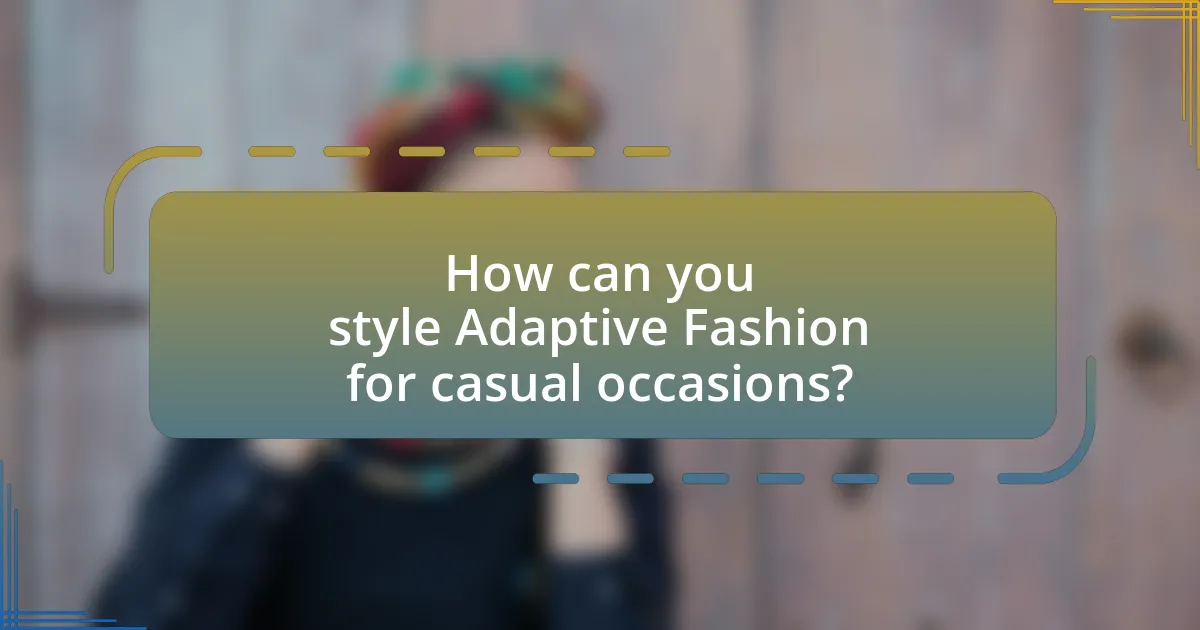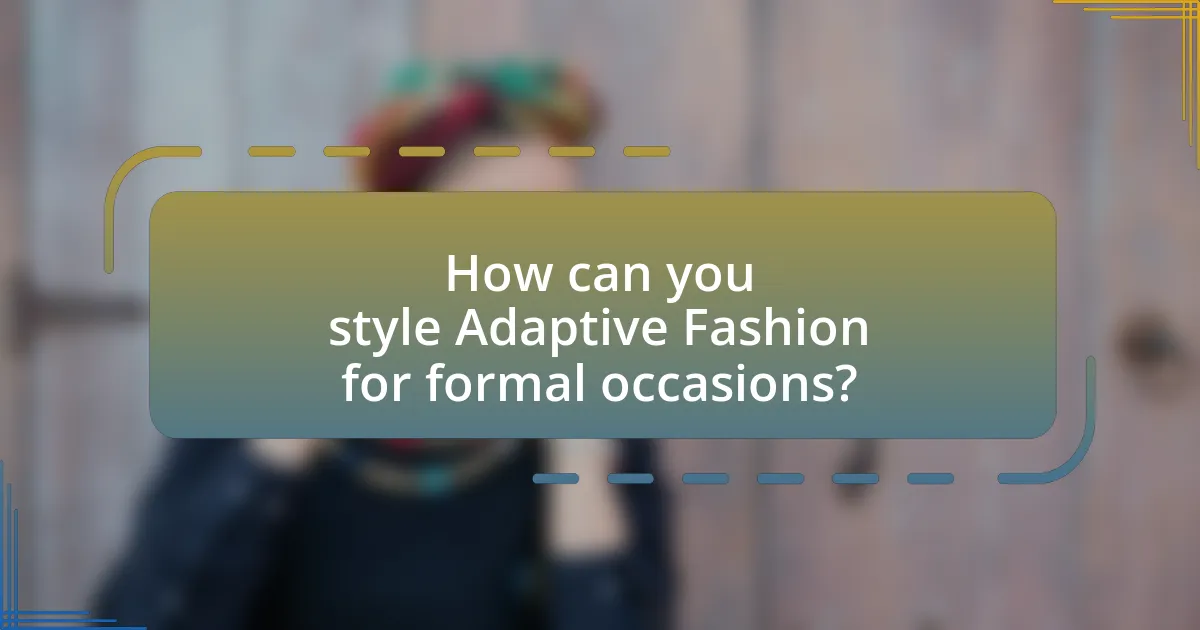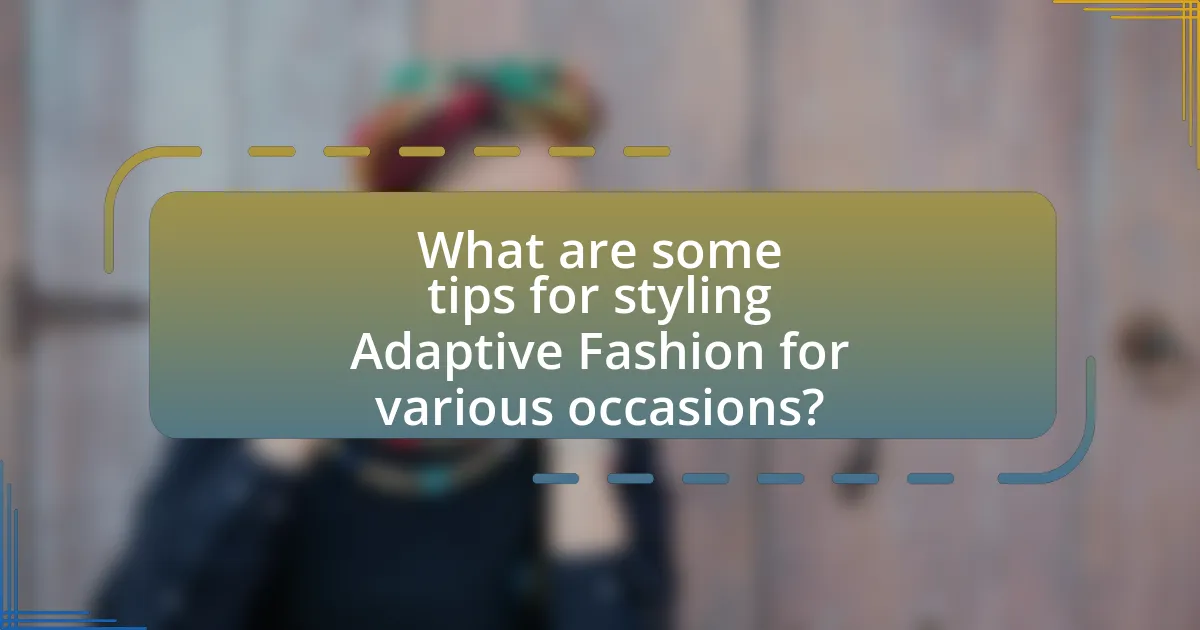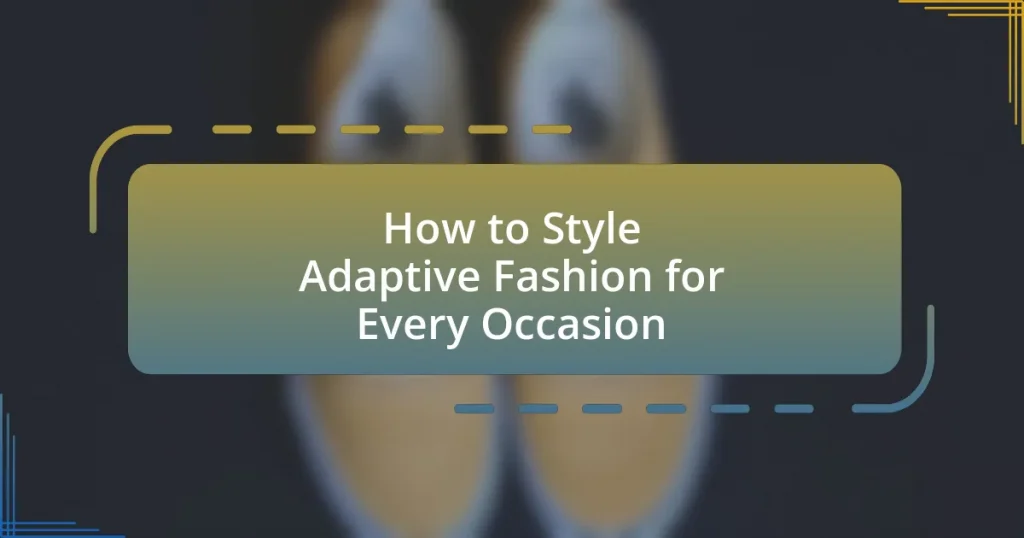Adaptive fashion is clothing specifically designed to meet the needs of individuals with disabilities or health conditions, incorporating features like adjustable fastenings and sensory-friendly materials for enhanced comfort and usability. This article explores how adaptive fashion differs from traditional fashion, highlighting its focus on inclusivity and functionality. Key features, types, and popular brands in the adaptive fashion space are discussed, along with styling tips for casual and formal occasions. Additionally, the article addresses how to personalize adaptive clothing to reflect individual style while ensuring practicality and comfort.

What is Adaptive Fashion?
Adaptive fashion refers to clothing designed specifically to meet the needs of individuals with disabilities or specific health conditions. This type of fashion incorporates features such as adjustable fastenings, easy-access designs, and sensory-friendly materials to enhance comfort and usability. The rise of adaptive fashion is supported by statistics indicating that approximately 1 in 5 people in the U.S. live with a disability, highlighting the demand for inclusive clothing options that cater to diverse body types and mobility challenges.
How does Adaptive Fashion differ from traditional fashion?
Adaptive fashion differs from traditional fashion primarily in its design focus on inclusivity and functionality for individuals with disabilities or specific needs. While traditional fashion emphasizes aesthetics and trends, adaptive fashion prioritizes ease of wear, accessibility, and comfort, often incorporating features like magnetic closures, adjustable fits, and sensory-friendly materials. This approach addresses the practical challenges faced by individuals with mobility issues, sensory sensitivities, or other disabilities, ensuring that clothing is not only stylish but also functional and accommodating.
What are the key features of Adaptive Fashion?
Adaptive fashion is characterized by its focus on inclusivity, functionality, and style, catering to individuals with diverse needs. Key features include adjustable closures, easy-to-wear designs, and the use of adaptive materials that enhance comfort and accessibility. For instance, garments may incorporate magnetic buttons or elastic waistbands to facilitate dressing for those with limited mobility. Additionally, adaptive fashion often emphasizes stylish aesthetics, ensuring that clothing is not only practical but also fashionable, thereby promoting self-expression and confidence among wearers.
Why is Adaptive Fashion important for inclusivity?
Adaptive fashion is important for inclusivity because it ensures that individuals with disabilities have access to clothing that meets their specific needs and preferences. This type of fashion promotes equal opportunities for self-expression and participation in society, allowing people with diverse abilities to feel confident and comfortable in their attire. According to a report by the Runway of Dreams Foundation, 1 in 5 Americans has a disability, highlighting the necessity for fashion that accommodates this significant portion of the population. By prioritizing adaptive fashion, the industry acknowledges and addresses the unique challenges faced by these individuals, fostering a more inclusive environment in both fashion and society at large.
What types of Adaptive Fashion exist?
Adaptive fashion includes various types designed to meet the needs of individuals with disabilities or specific health conditions. These types include adaptive clothing, which features modifications like magnetic closures or adjustable fits; sensory-friendly apparel, designed to minimize discomfort for those with sensory sensitivities; and medical garments, which accommodate medical devices or treatments. Additionally, there are inclusive designs that cater to a wide range of body types and mobility challenges. The existence of these categories is supported by the growing demand for accessible fashion, as evidenced by the increasing number of brands focusing on inclusivity and functionality in their collections.
How do different styles cater to various disabilities?
Different styles cater to various disabilities by incorporating specific design elements that address individual needs. For instance, adaptive clothing often features adjustable closures, magnetic fasteners, and stretchable fabrics, making it easier for individuals with limited mobility to dress independently. Research indicates that 1 in 5 people in the U.S. live with a disability, highlighting the importance of inclusive fashion that accommodates diverse physical challenges. Additionally, styles that prioritize sensory-friendly materials can benefit individuals with sensory processing disorders, as these fabrics reduce discomfort and irritation. By focusing on functionality and comfort, adaptive fashion effectively meets the unique requirements of people with disabilities.
What are some popular brands in the Adaptive Fashion space?
Some popular brands in the Adaptive Fashion space include Tommy Hilfiger, Zappos Adaptive, and Nike’s FlyEase line. Tommy Hilfiger launched its adaptive clothing line in 2016, focusing on stylish, functional designs for individuals with disabilities. Zappos Adaptive offers a wide range of adaptive footwear and apparel, catering to various needs. Nike’s FlyEase line features innovative designs that allow for easy wear, promoting inclusivity in sportswear. These brands are recognized for their commitment to creating fashionable and accessible clothing options.

How can you style Adaptive Fashion for casual occasions?
To style Adaptive Fashion for casual occasions, focus on comfortable, versatile pieces that accommodate various needs while maintaining a relaxed aesthetic. Incorporate items such as stretchable jeans, breathable t-shirts, and lightweight jackets that allow for easy movement and accessibility. For instance, brands like Tommy Hilfiger and Zappos Adaptive offer clothing designed with adaptive features, such as magnetic closures and adjustable waistbands, which enhance comfort without sacrificing style. This approach ensures that individuals can express their personal style while enjoying the practicality of adaptive clothing in everyday settings.
What are the best casual Adaptive Fashion pieces?
The best casual Adaptive Fashion pieces include adjustable waist pants, magnetic closure shirts, and slip-on shoes. Adjustable waist pants provide comfort and ease of wear, accommodating various body types and mobility needs. Magnetic closure shirts simplify dressing for individuals with limited dexterity, allowing for quick and easy changes. Slip-on shoes offer convenience and accessibility, making them ideal for casual outings. These pieces are designed to enhance comfort and style while addressing specific adaptive needs, ensuring that individuals can enjoy fashion without compromising functionality.
How can layering enhance casual Adaptive outfits?
Layering enhances casual Adaptive outfits by providing versatility and comfort, allowing individuals to adjust their clothing to suit varying temperatures and personal preferences. This technique enables the incorporation of different textures and styles, which can accommodate specific needs, such as ease of dressing or mobility. For instance, lightweight, breathable fabrics can be layered to create a stylish yet functional look, while adaptive features like magnetic closures or adjustable hems can be seamlessly integrated into the layers. This approach not only promotes individual expression but also ensures that the outfits remain practical and accessible, catering to the diverse requirements of adaptive fashion.
What accessories complement casual Adaptive Fashion?
Accessories that complement casual Adaptive Fashion include functional bags, adaptive footwear, and versatile hats. Functional bags, such as crossbody or backpack styles, provide ease of access and comfort, catering to various mobility needs. Adaptive footwear, designed for easy wear and comfort, often features adjustable closures and supportive designs, enhancing both style and practicality. Versatile hats, like beanies or caps, not only add a fashionable touch but also offer protection from the elements, making them suitable for various casual settings. These accessories are essential in ensuring that casual Adaptive Fashion remains stylish while accommodating individual needs.
How do you choose colors and patterns for casual Adaptive Fashion?
Choosing colors and patterns for casual Adaptive Fashion involves considering both functionality and personal expression. The selection process should prioritize colors that enhance visibility and patterns that accommodate various body types and mobility needs. For instance, high-contrast colors can improve visibility for individuals with visual impairments, while patterns that are not overly complex can simplify the dressing process for those with dexterity challenges. Research indicates that individuals often feel more confident and comfortable in clothing that reflects their personal style, which underscores the importance of incorporating preferred colors and patterns into adaptive designs.
What color palettes work best for different skin tones?
Warm skin tones look best in earthy colors like oranges, yellows, and warm reds, as well as golds and browns. Cool skin tones are complemented by jewel tones such as blues, purples, and emerald greens, along with silver and icy shades. Neutral skin tones can wear a mix of both warm and cool colors, including soft pastels and muted tones. This classification is supported by color theory, which indicates that skin undertones influence how colors appear on an individual, enhancing their overall look.
How can patterns be used to express personal style?
Patterns can be used to express personal style by allowing individuals to showcase their unique preferences and creativity through clothing choices. For instance, bold geometric patterns can convey a modern and edgy aesthetic, while floral patterns often reflect a more romantic or whimsical style. Research indicates that clothing patterns can significantly influence perceptions of personality; a study published in the Journal of Fashion Marketing and Management found that individuals wearing patterned clothing are often perceived as more approachable and expressive. This demonstrates that the choice of patterns not only enhances personal style but also communicates aspects of one’s identity to others.

How can you style Adaptive Fashion for formal occasions?
To style Adaptive Fashion for formal occasions, select tailored pieces that offer both elegance and functionality, such as blazers with adjustable features or dresses with easy-access closures. Incorporating high-quality fabrics like silk or wool enhances the formal aesthetic while ensuring comfort. Accessories like statement jewelry and stylish shoes can elevate the overall look, making it suitable for events like weddings or corporate gatherings. Research indicates that adaptive clothing can significantly improve the confidence and self-expression of individuals with disabilities, reinforcing the importance of style in formal settings.
What are the key elements of formal Adaptive Fashion?
The key elements of formal Adaptive Fashion include functionality, inclusivity, and style. Functionality ensures that clothing accommodates various physical needs, such as easy dressing and mobility, often incorporating features like magnetic closures or adjustable fits. Inclusivity emphasizes designs that cater to diverse body types and disabilities, promoting equal access to fashion. Style integrates current fashion trends, ensuring that adaptive clothing is visually appealing and suitable for formal occasions. These elements collectively enhance the wearer’s experience, allowing individuals with disabilities to express their personal style while meeting their specific needs.
How can tailoring improve the fit of formal Adaptive wear?
Tailoring can significantly improve the fit of formal adaptive wear by customizing garments to accommodate individual body shapes and mobility needs. This customization ensures that clothing not only fits well but also allows for ease of movement, which is essential for individuals with disabilities. Tailored adaptive wear can incorporate features such as adjustable closures, modified seams, and strategic cuts that enhance comfort and functionality. Studies have shown that well-fitted clothing can positively impact the wearer’s confidence and overall well-being, making tailoring a crucial aspect of adaptive fashion.
What types of fabrics are best for formal Adaptive Fashion?
The best types of fabrics for formal Adaptive Fashion include stretchable materials like spandex blends, breathable fabrics such as cotton and linen, and luxurious options like silk and wool. Stretchable materials provide comfort and ease of movement, which is essential for adaptive clothing designed for individuals with varying mobility needs. Breathable fabrics ensure comfort during extended wear, while silk and wool offer a refined appearance suitable for formal settings. These fabric choices cater to both functionality and style, making them ideal for formal adaptive wear.
How can you accessorize formal Adaptive outfits?
To accessorize formal adaptive outfits, incorporate functional yet stylish elements such as adaptive jewelry, belts, and bags designed for ease of use. Adaptive jewelry, like magnetic clasps or adjustable pieces, enhances elegance while ensuring accessibility. Belts with easy closures can provide a polished look while accommodating various body types. Additionally, bags with adaptive features, such as crossbody styles or those with easy-open zippers, offer practicality without sacrificing style. These accessories not only complement the formal attire but also cater to the specific needs of individuals, ensuring comfort and confidence in their appearance.
What types of shoes are suitable for formal Adaptive wear?
Formal adaptive wear is best complemented by shoes that offer both style and accessibility. Suitable types include dress shoes with adjustable features, such as Velcro straps or elastic laces, which provide ease of wear while maintaining a polished appearance. Additionally, loafers and slip-on shoes are ideal as they allow for easy on-and-off access without compromising on formality. Research indicates that adaptive footwear designed for formal occasions can enhance comfort and confidence, making them a practical choice for individuals with mobility challenges.
How can jewelry enhance a formal Adaptive look?
Jewelry can enhance a formal Adaptive look by adding sophistication and personal expression to the outfit. For instance, statement necklaces or elegant earrings can draw attention to the face and elevate the overall appearance, making the look more polished. Additionally, jewelry can serve functional purposes, such as adaptive pieces designed for ease of wear, which can be particularly beneficial for individuals with mobility challenges. Research indicates that accessorizing can significantly impact perceived professionalism and confidence, reinforcing the importance of jewelry in formal settings.

What are some tips for styling Adaptive Fashion for various occasions?
To style Adaptive Fashion for various occasions, prioritize comfort, functionality, and personal expression. For casual outings, opt for breathable fabrics and easy-to-wear designs that allow for mobility, such as elastic waistbands and adjustable features. For formal events, choose tailored pieces that incorporate adaptive elements, like hidden closures or magnetic buttons, ensuring a polished look without sacrificing ease of wear. When dressing for active environments, select moisture-wicking materials and layered options that accommodate different temperatures and activities. Research indicates that adaptive clothing can enhance confidence and independence, making it essential to choose styles that reflect individual preferences while meeting practical needs.
How can you mix and match Adaptive Fashion pieces effectively?
To mix and match Adaptive Fashion pieces effectively, focus on selecting versatile items that can be layered or combined in various ways. For instance, choose a neutral base layer, such as a fitted top, and pair it with adaptive bottoms that offer comfort and style, like adjustable waist pants. Incorporating accessories, such as scarves or statement jewelry, can enhance the overall look while allowing for personal expression. Research indicates that individuals who utilize a capsule wardrobe approach, which emphasizes a limited selection of interchangeable clothing, report increased satisfaction and ease in styling (source: “The Capsule Wardrobe: A Guide to Minimalist Fashion” by Jennifer Scott). This method not only simplifies outfit choices but also maximizes the potential of each piece in the wardrobe.
What are some common mistakes to avoid when styling Adaptive Fashion?
Common mistakes to avoid when styling Adaptive Fashion include neglecting functionality, overlooking personal style, and failing to consider fabric choices. Neglecting functionality can lead to clothing that is difficult to wear or manage, which defeats the purpose of adaptive fashion. Overlooking personal style may result in outfits that do not reflect the individual’s identity, making them feel uncomfortable or less confident. Additionally, failing to consider fabric choices can lead to discomfort; for instance, selecting materials that do not breathe well can exacerbate physical challenges. These mistakes can hinder the effectiveness of adaptive fashion, which aims to combine style with practicality for diverse needs.
How can you personalize Adaptive Fashion to reflect your style?
You can personalize Adaptive Fashion to reflect your style by selecting clothing that aligns with your personal aesthetic, incorporating unique accessories, and choosing colors and patterns that resonate with you. For instance, individuals can opt for adaptive garments that feature adjustable elements, allowing for a customized fit while still showcasing personal flair. Additionally, using accessories like statement jewelry or scarves can enhance the overall look, making it distinctly yours. Research indicates that personal expression through fashion can significantly boost self-esteem and confidence, underscoring the importance of tailoring adaptive clothing to individual preferences.














